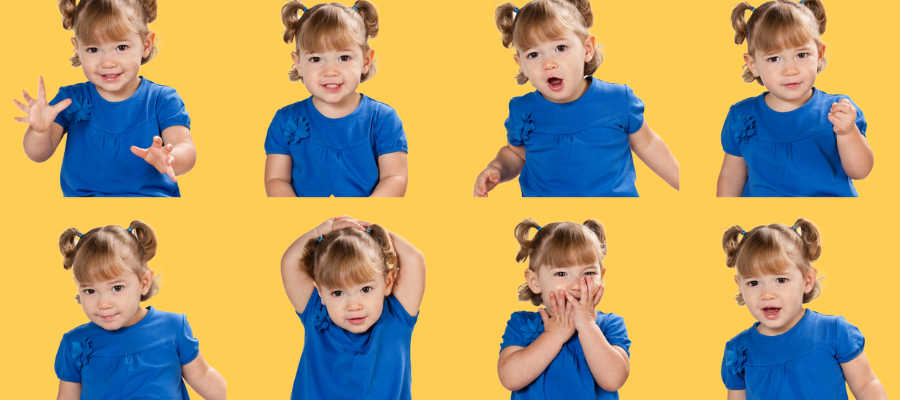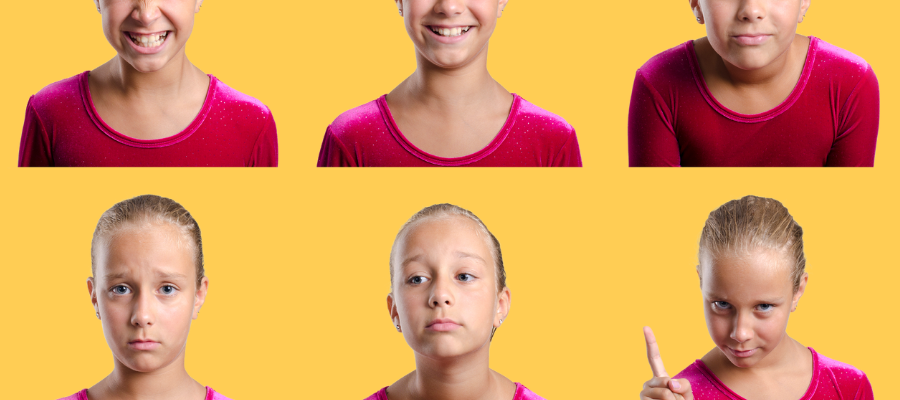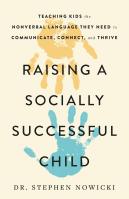Parent Toolkit: Tips to Help Your Child with Facial Expressions
Excerpted from Dr. Stephen Nowicki’s book on how to teach kids the nonverbal language they need to communicate, connect, and thrive. Based on over 30 years of research.
Facial expressions are crucial to relationships because they serve a very important function: the sending and receiving of emotional information. For most people, our emotions are literally written all over our faces. When we communicate with one another in person we’re constantly sending out signals using our facial expressions, whether we are speaking or silent. We have an incredible forty- three different muscles in our faces, allowing us to produce more than ten thousand discriminable expressions that communicate a remarkable range of emotions. Even a simple smile can be a complex matter, requiring the use of our eyes, mouth, and other facial movements.
What’s curious is that despite the complexity of facial expressions, most children are not taught their meaning in school. Instead, they are left to figure out this important communication mode for themselves, sometimes making more than a few mistakes along the way.
On the whole, psychologists agree that facial expressions are much more powerful than the words we use. Children as young as four years of age are able to produce a convincingly happy expression to cover up their true feelings. In fact, adults sometimes actively teach children to cover up their feelings in this way, asking them to smile and say thank you for an unwanted gift rather than frowning and pouting, for example. Many of the aspects of our early training in what might be included under the heading of “manners” or “social graces” are in fact teaching children to conceal their emotions via their facial expressions, and they only become better at this with age. But while there are times when we might be able to successfully cover up our true feelings, we can’t hide the fact that our faces are out there for everyone to see.

Tips to Help a Very Young Child with Facial Expressions
1. Practice making a range of facial expressions on your own.
The primary way infants and children in early childhood learn to express themselves via this channel (and others) is by mimicking their caregivers. As most adults don’t spend a lot of time analyzing their own facial expressions, it’s worth taking some time to look in the bathroom mirror in order to evaluate your own ability to express happiness, sadness, anger, and fear. Then try out your newfound expressiveness with your child. As a side benefit, the bigger and more exaggerated you can make your facial expressions with very young children, the more they will connect and engage with you.
2. Practice making a range of facial expressions on your own.
Like all the nonverbal channels, facial expressions are rarely taught directly — but they can be. When your child is a baby, you can play simple games such as peekaboo and “Who is that in the mirror?” to help him gain practice in reading faces and an understanding of the way his own face communicates emotion in return. As your child grows and acquires language, you can continue to make faces with him and encourage him to make faces with differing degrees of intensity (for example, a “mad” face, then a “really mad” face, then a face that’s only “a little bit mad”) back at you.
You can also teach your child some general rules about the context in which these expressions are appropriate and inappropriate. For example, “You just got the big ice cream cone you wanted, and you are really happy. Make a happy face!” Then: “Oh my! You just dropped your ice cream cone, it’s spoiled, and you are really sad. Make a sad face.” In this way, your child will begin to connect facial expressions with feelings and with the scenarios in which he can use these nonverbal cues to express himself.
3. Use photos.
You can look through photos on your phone with your child, asking her to spot and name different expressions, then connect them to the relevant emotion, such as “Grandma is smiling, so she is happy”; “my brother is scowling, so he is upset.” Young children tend to enjoy posing for and taking photos, so you can even play a game of “model and photographer,” taking turns with the camera while the other person smiles, grimaces, and makes a surprised or fearful face. Then you can look at the photos together and talk about the different emotions and how successful you were at conveying them.
4. Read picture books and talk about the emotions you see in the characters’ faces.
Many children’s books feature characters that go on emotional journeys over the course of the narrative. As you read to your child, anytime there is an emotion displayed in an illustration, you can point to it and ask him to name it. The Elephant and Piggie books, written and illustrated by Mo Willems, are particularly well suited to this. After you’ve finished the story, you can talk to your child about how Gerald the elephant expresses himself using his face as well as his words, and how his best friend, Piggie, responds. Then you and your child can play around mimicking the faces of the characters in the book.
Singing old- fashioned nursery rhymes can also be a good prompt. When you get to the end of the rhyme, ask your child to (nonverbally) express the emotion consistent with the ending. How does he feel about Jack falling down and Jill coming tumbling after? Can he make a facial expression to show that emotion?
5. Be mindful of your own facial expressions when you’re around your young child.
Most parents and caregivers aren’t aware of how much emotional information their children — particularly very young children — pick up in their facial expressions. If you’re upset by something that doesn’t have anything to do with your child — and your face shows anger, sadness, or fear as a result — your child may react as though those emotions were meant for him. (We sometimes make that same mistake as adults when our partners or spouses are upset about something that has nothing to do with us — but unlike very young children, we can use verbal language to investigate whether the emotions are directed at us or not.) Keep this in mind when you’re with your child and make sure your expressions are consistent with any messages you’d wish him to receive.
6. Make sure to sit down for mealtimes with your child.
One simple but powerful way to give your child additional opportunities to observe and practice facial expressions is to prioritize family meals — and make the dining table a screen- free zone. Research shows that one of the best sources of nonverbal learning is time spent eating together as a family. Moreover, children whose families eat together more than three times a week have better relationships, do better at school, are more resilient in the face of adversity, and are less likely to get into trouble.
During mealtimes, you can model appropriate facial expressions — and appropriate interactions in general — for your child. When you include others, such as extended family and friends, not only do you give your child exposure to a greater range of all types of nonverbal behaviors and styles, but you also show him how relationships work and how important they are. I can still remember my grandfather telling me the story over dinner of how when he first saw my grandmother’s warm smile it so captivated him, even from a distance, that he just had to meet and learn more about her — that smile became the reason for my existence! Family mealtimes offer children a wealth of nonverbal learning opportunities and are well worth taking the time to build into your day.

Tips for Helping Your Child with Facial Expressions in Late Childhood
1. Observe what your child’s face is saying.
Next time you have the opportunity, observe your child within a group of children of a similar age. Watch as they eat, play, and speak to one another in order to see how well your child uses facial expressions to express his emotions. Does he make eye contact with others or spend a lot of time looking away or to the ground? Does he notice other children’s facial expressions, perhaps going over to play with a child who is looking sad? Does he smile with excitement when someone includes him in a game? It’s also important to find out what your child’s resting face is communicating. Watch for those situations in which your child is looking out a window or sitting quietly with a book and observe what the resting face looks like or scroll through photos of your child to see if he has a characteristic expression when he is not looking at the camera or posing. Then note what this expression appears to be communicating emotionally.
2. Use stories.
One way to teach your child about facial expressions is through stories. If your child is telling you about something that happened at school, you could ask him, “How did so- and so feel about that?” and “How could you tell?” Explain that different situations require different expressions. You can say, “A big happy smile when you see a friend is a great way to greet them,” or “If your friend is feeling sad, you can make a sad face to let them know you understand.” When you’re looking at books or magazines with your child, ask him what each expression is showing. Another idea is to watch TV programs or movies with your child and then turn the sound off so he can concentrate on the facial expressions. Hit pause at various places and ask your child how he thinks the character feels in that moment, and why. Daytime soaps are an especially good source of facial expressions of emotions at all levels of intensity — just make sure the content is age- appropriate!
3. Talk to your child about his resting face.
First, introduce the concept of a resting face to your child, and explain how important it is to have a happy, welcoming resting face so that others will want to come over and play with him. You can show your child photos of his own resting face or ask him to identify the resting faces of others when you’re out walking or on public transport. Then have your child practice different versions of his resting face in the mirror and talk about what they communicate.
4. Enroll your child in theater or improv classes.
Getting involved in any kind of drama or theater program is a great way for children to hone their skill in facial expressions, as of course these are one of the primary ways that actors express what characters are feeling. When your child is learning how to communicate his character’s emotion to the audience, he’s learning how to express himself when off the stage as well.

